QUT XNH355 Nutrition Report: Critical Analysis of Egg Intake and CVD
VerifiedAdded on 2023/06/11
|8
|3402
|297
Report
AI Summary
This report assesses the association between egg consumption and cardiovascular disease (CVD) risk by analyzing two journal articles. The first article, a prospective cohort study on Korean adults, found no significant association between egg intake and CVD incidence overall, but observed a higher risk among diabetic participants with high egg consumption. The second article, a randomized controlled trial, examined the impact of high- and low-egg diets on lipid profiles in obese individuals with type 2 diabetes, revealing no significant differences in HDL cholesterol levels between the groups. Both studies employed different methodologies for nutritional exposure assessment, including semi-quantitative food frequency questionnaires and dietary interventions. While the cohort study benefited from a large sample size, it faced limitations related to residual confounding and recall bias. The randomized controlled trial, though limited by a smaller sample size, adhered to strict clinical practice guidelines. The report critically evaluates the study designs, findings, and evidence quality, highlighting the complexities of determining the precise relationship between egg consumption and CVD risk.
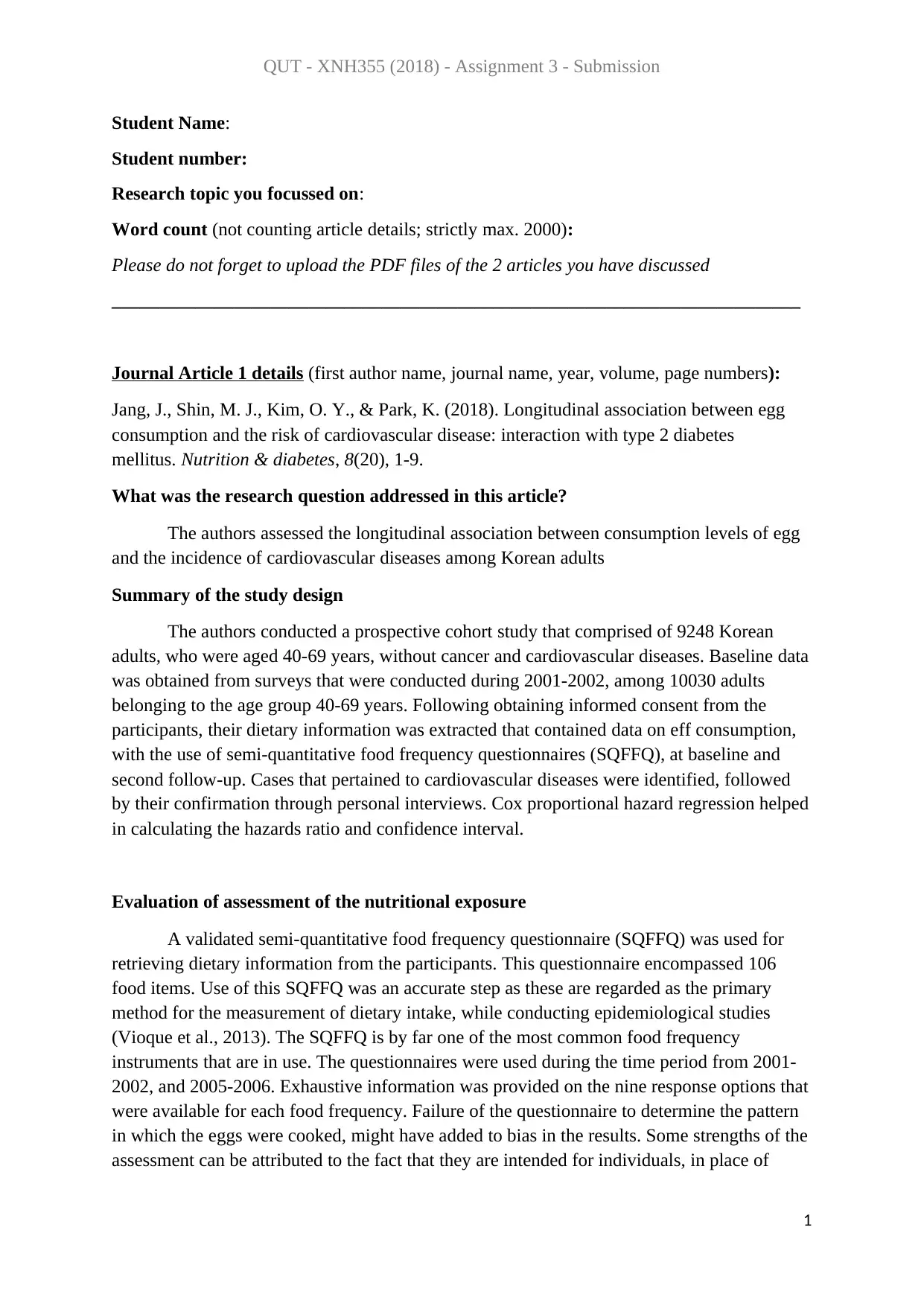
QUT - XNH355 (2018) - Assignment 3 - Submission
Student Name:
Student number:
Research topic you focussed on:
Word count (not counting article details; strictly max. 2000):
Please do not forget to upload the PDF files of the 2 articles you have discussed
__________________________________________________________________________
Journal Article 1 details (first author name, journal name, year, volume, page numbers):
Jang, J., Shin, M. J., Kim, O. Y., & Park, K. (2018). Longitudinal association between egg
consumption and the risk of cardiovascular disease: interaction with type 2 diabetes
mellitus. Nutrition & diabetes, 8(20), 1-9.
What was the research question addressed in this article?
The authors assessed the longitudinal association between consumption levels of egg
and the incidence of cardiovascular diseases among Korean adults
Summary of the study design
The authors conducted a prospective cohort study that comprised of 9248 Korean
adults, who were aged 40-69 years, without cancer and cardiovascular diseases. Baseline data
was obtained from surveys that were conducted during 2001-2002, among 10030 adults
belonging to the age group 40-69 years. Following obtaining informed consent from the
participants, their dietary information was extracted that contained data on eff consumption,
with the use of semi-quantitative food frequency questionnaires (SQFFQ), at baseline and
second follow-up. Cases that pertained to cardiovascular diseases were identified, followed
by their confirmation through personal interviews. Cox proportional hazard regression helped
in calculating the hazards ratio and confidence interval.
Evaluation of assessment of the nutritional exposure
A validated semi-quantitative food frequency questionnaire (SQFFQ) was used for
retrieving dietary information from the participants. This questionnaire encompassed 106
food items. Use of this SQFFQ was an accurate step as these are regarded as the primary
method for the measurement of dietary intake, while conducting epidemiological studies
(Vioque et al., 2013). The SQFFQ is by far one of the most common food frequency
instruments that are in use. The questionnaires were used during the time period from 2001-
2002, and 2005-2006. Exhaustive information was provided on the nine response options that
were available for each food frequency. Failure of the questionnaire to determine the pattern
in which the eggs were cooked, might have added to bias in the results. Some strengths of the
assessment can be attributed to the fact that they are intended for individuals, in place of
1
Student Name:
Student number:
Research topic you focussed on:
Word count (not counting article details; strictly max. 2000):
Please do not forget to upload the PDF files of the 2 articles you have discussed
__________________________________________________________________________
Journal Article 1 details (first author name, journal name, year, volume, page numbers):
Jang, J., Shin, M. J., Kim, O. Y., & Park, K. (2018). Longitudinal association between egg
consumption and the risk of cardiovascular disease: interaction with type 2 diabetes
mellitus. Nutrition & diabetes, 8(20), 1-9.
What was the research question addressed in this article?
The authors assessed the longitudinal association between consumption levels of egg
and the incidence of cardiovascular diseases among Korean adults
Summary of the study design
The authors conducted a prospective cohort study that comprised of 9248 Korean
adults, who were aged 40-69 years, without cancer and cardiovascular diseases. Baseline data
was obtained from surveys that were conducted during 2001-2002, among 10030 adults
belonging to the age group 40-69 years. Following obtaining informed consent from the
participants, their dietary information was extracted that contained data on eff consumption,
with the use of semi-quantitative food frequency questionnaires (SQFFQ), at baseline and
second follow-up. Cases that pertained to cardiovascular diseases were identified, followed
by their confirmation through personal interviews. Cox proportional hazard regression helped
in calculating the hazards ratio and confidence interval.
Evaluation of assessment of the nutritional exposure
A validated semi-quantitative food frequency questionnaire (SQFFQ) was used for
retrieving dietary information from the participants. This questionnaire encompassed 106
food items. Use of this SQFFQ was an accurate step as these are regarded as the primary
method for the measurement of dietary intake, while conducting epidemiological studies
(Vioque et al., 2013). The SQFFQ is by far one of the most common food frequency
instruments that are in use. The questionnaires were used during the time period from 2001-
2002, and 2005-2006. Exhaustive information was provided on the nine response options that
were available for each food frequency. Failure of the questionnaire to determine the pattern
in which the eggs were cooked, might have added to bias in the results. Some strengths of the
assessment can be attributed to the fact that they are intended for individuals, in place of
1
Paraphrase This Document
Need a fresh take? Get an instant paraphrase of this document with our AI Paraphraser
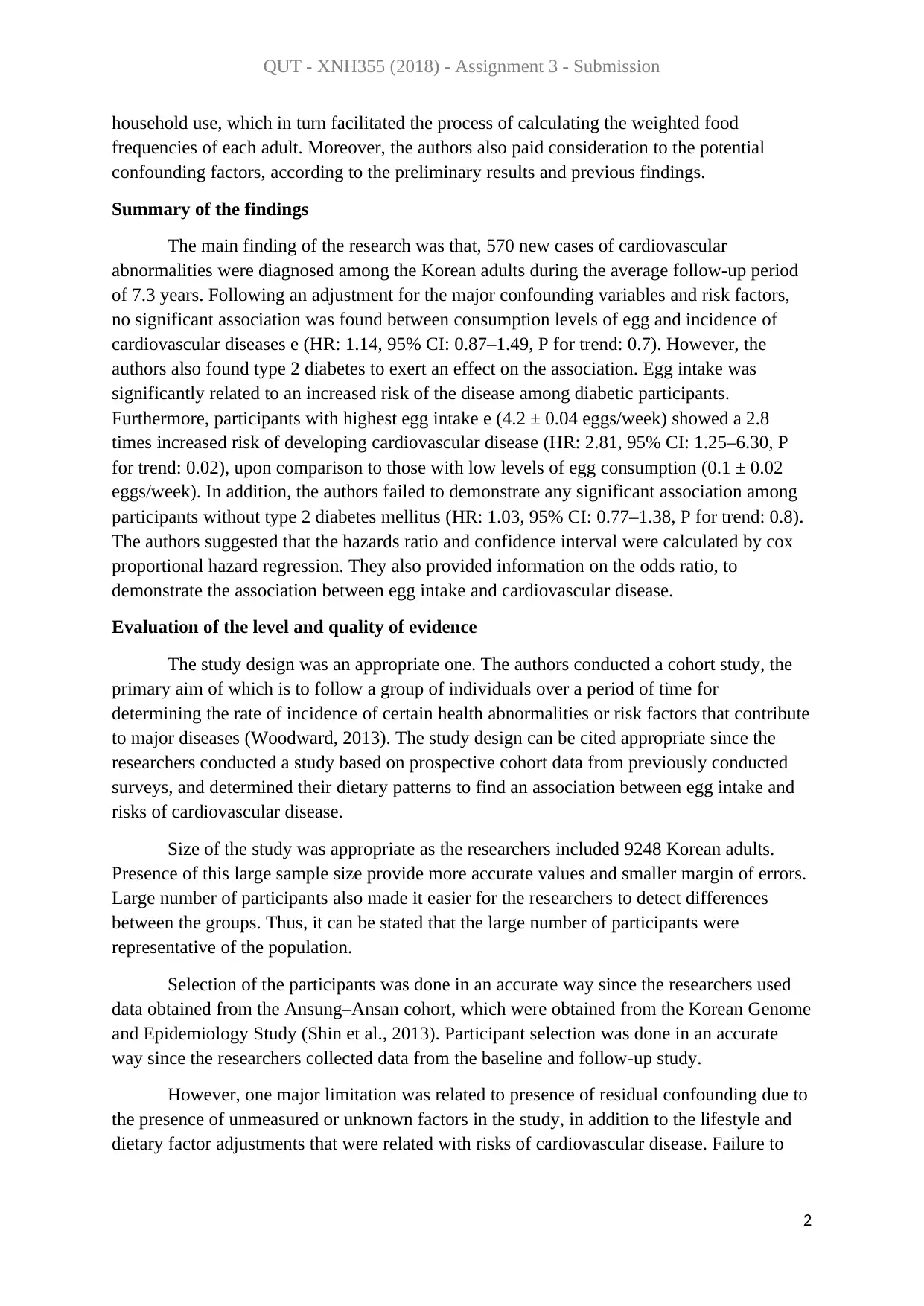
QUT - XNH355 (2018) - Assignment 3 - Submission
household use, which in turn facilitated the process of calculating the weighted food
frequencies of each adult. Moreover, the authors also paid consideration to the potential
confounding factors, according to the preliminary results and previous findings.
Summary of the findings
The main finding of the research was that, 570 new cases of cardiovascular
abnormalities were diagnosed among the Korean adults during the average follow-up period
of 7.3 years. Following an adjustment for the major confounding variables and risk factors,
no significant association was found between consumption levels of egg and incidence of
cardiovascular diseases e (HR: 1.14, 95% CI: 0.87–1.49, P for trend: 0.7). However, the
authors also found type 2 diabetes to exert an effect on the association. Egg intake was
significantly related to an increased risk of the disease among diabetic participants.
Furthermore, participants with highest egg intake e (4.2 ± 0.04 eggs/week) showed a 2.8
times increased risk of developing cardiovascular disease (HR: 2.81, 95% CI: 1.25–6.30, P
for trend: 0.02), upon comparison to those with low levels of egg consumption (0.1 ± 0.02
eggs/week). In addition, the authors failed to demonstrate any significant association among
participants without type 2 diabetes mellitus (HR: 1.03, 95% CI: 0.77–1.38, P for trend: 0.8).
The authors suggested that the hazards ratio and confidence interval were calculated by cox
proportional hazard regression. They also provided information on the odds ratio, to
demonstrate the association between egg intake and cardiovascular disease.
Evaluation of the level and quality of evidence
The study design was an appropriate one. The authors conducted a cohort study, the
primary aim of which is to follow a group of individuals over a period of time for
determining the rate of incidence of certain health abnormalities or risk factors that contribute
to major diseases (Woodward, 2013). The study design can be cited appropriate since the
researchers conducted a study based on prospective cohort data from previously conducted
surveys, and determined their dietary patterns to find an association between egg intake and
risks of cardiovascular disease.
Size of the study was appropriate as the researchers included 9248 Korean adults.
Presence of this large sample size provide more accurate values and smaller margin of errors.
Large number of participants also made it easier for the researchers to detect differences
between the groups. Thus, it can be stated that the large number of participants were
representative of the population.
Selection of the participants was done in an accurate way since the researchers used
data obtained from the Ansung–Ansan cohort, which were obtained from the Korean Genome
and Epidemiology Study (Shin et al., 2013). Participant selection was done in an accurate
way since the researchers collected data from the baseline and follow-up study.
However, one major limitation was related to presence of residual confounding due to
the presence of unmeasured or unknown factors in the study, in addition to the lifestyle and
dietary factor adjustments that were related with risks of cardiovascular disease. Failure to
2
household use, which in turn facilitated the process of calculating the weighted food
frequencies of each adult. Moreover, the authors also paid consideration to the potential
confounding factors, according to the preliminary results and previous findings.
Summary of the findings
The main finding of the research was that, 570 new cases of cardiovascular
abnormalities were diagnosed among the Korean adults during the average follow-up period
of 7.3 years. Following an adjustment for the major confounding variables and risk factors,
no significant association was found between consumption levels of egg and incidence of
cardiovascular diseases e (HR: 1.14, 95% CI: 0.87–1.49, P for trend: 0.7). However, the
authors also found type 2 diabetes to exert an effect on the association. Egg intake was
significantly related to an increased risk of the disease among diabetic participants.
Furthermore, participants with highest egg intake e (4.2 ± 0.04 eggs/week) showed a 2.8
times increased risk of developing cardiovascular disease (HR: 2.81, 95% CI: 1.25–6.30, P
for trend: 0.02), upon comparison to those with low levels of egg consumption (0.1 ± 0.02
eggs/week). In addition, the authors failed to demonstrate any significant association among
participants without type 2 diabetes mellitus (HR: 1.03, 95% CI: 0.77–1.38, P for trend: 0.8).
The authors suggested that the hazards ratio and confidence interval were calculated by cox
proportional hazard regression. They also provided information on the odds ratio, to
demonstrate the association between egg intake and cardiovascular disease.
Evaluation of the level and quality of evidence
The study design was an appropriate one. The authors conducted a cohort study, the
primary aim of which is to follow a group of individuals over a period of time for
determining the rate of incidence of certain health abnormalities or risk factors that contribute
to major diseases (Woodward, 2013). The study design can be cited appropriate since the
researchers conducted a study based on prospective cohort data from previously conducted
surveys, and determined their dietary patterns to find an association between egg intake and
risks of cardiovascular disease.
Size of the study was appropriate as the researchers included 9248 Korean adults.
Presence of this large sample size provide more accurate values and smaller margin of errors.
Large number of participants also made it easier for the researchers to detect differences
between the groups. Thus, it can be stated that the large number of participants were
representative of the population.
Selection of the participants was done in an accurate way since the researchers used
data obtained from the Ansung–Ansan cohort, which were obtained from the Korean Genome
and Epidemiology Study (Shin et al., 2013). Participant selection was done in an accurate
way since the researchers collected data from the baseline and follow-up study.
However, one major limitation was related to presence of residual confounding due to
the presence of unmeasured or unknown factors in the study, in addition to the lifestyle and
dietary factor adjustments that were related with risks of cardiovascular disease. Failure to
2
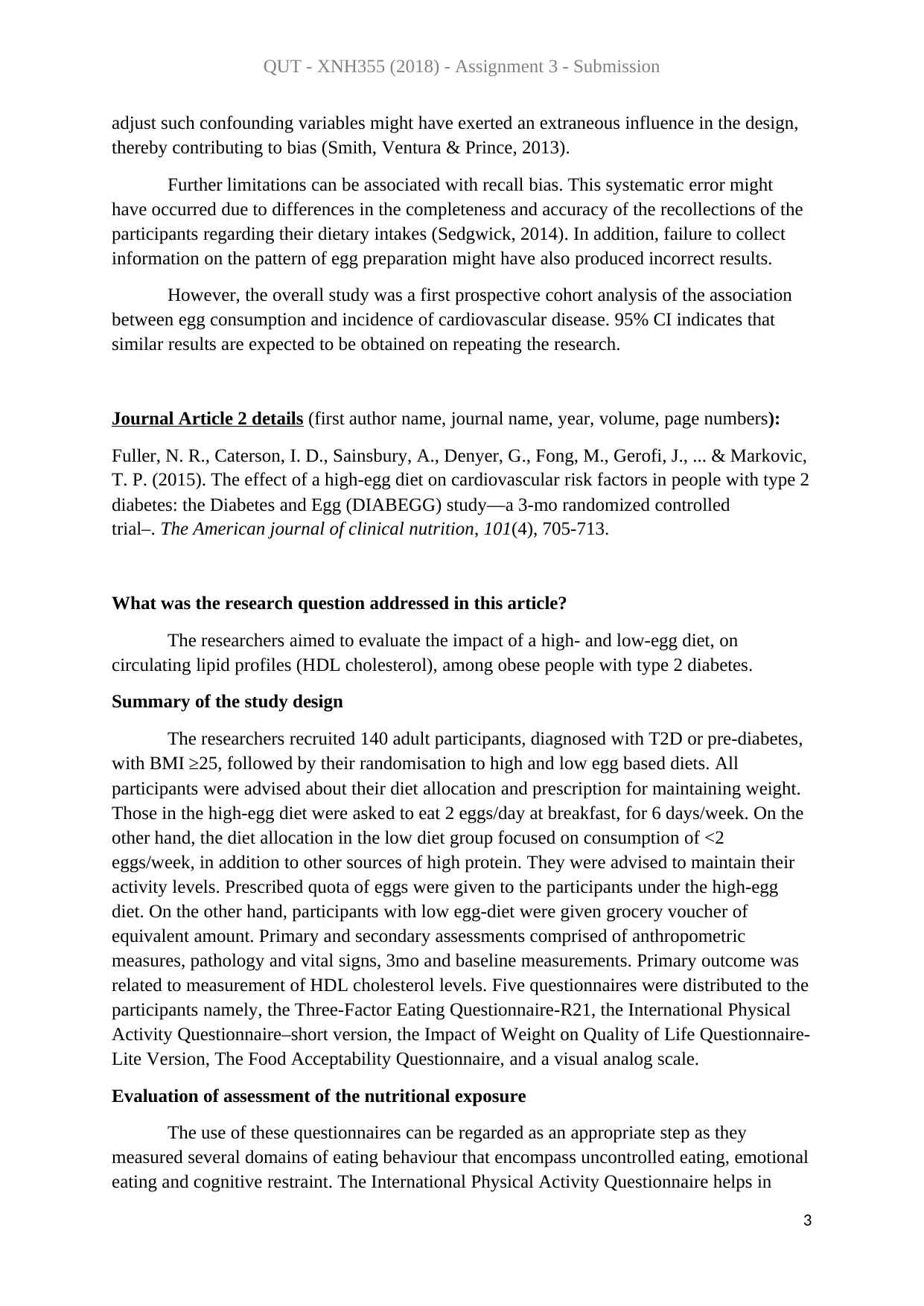
QUT - XNH355 (2018) - Assignment 3 - Submission
adjust such confounding variables might have exerted an extraneous influence in the design,
thereby contributing to bias (Smith, Ventura & Prince, 2013).
Further limitations can be associated with recall bias. This systematic error might
have occurred due to differences in the completeness and accuracy of the recollections of the
participants regarding their dietary intakes (Sedgwick, 2014). In addition, failure to collect
information on the pattern of egg preparation might have also produced incorrect results.
However, the overall study was a first prospective cohort analysis of the association
between egg consumption and incidence of cardiovascular disease. 95% CI indicates that
similar results are expected to be obtained on repeating the research.
Journal Article 2 details (first author name, journal name, year, volume, page numbers):
Fuller, N. R., Caterson, I. D., Sainsbury, A., Denyer, G., Fong, M., Gerofi, J., ... & Markovic,
T. P. (2015). The effect of a high-egg diet on cardiovascular risk factors in people with type 2
diabetes: the Diabetes and Egg (DIABEGG) study—a 3-mo randomized controlled
trial–. The American journal of clinical nutrition, 101(4), 705-713.
What was the research question addressed in this article?
The researchers aimed to evaluate the impact of a high- and low-egg diet, on
circulating lipid profiles (HDL cholesterol), among obese people with type 2 diabetes.
Summary of the study design
The researchers recruited 140 adult participants, diagnosed with T2D or pre-diabetes,
with BMI ≥25, followed by their randomisation to high and low egg based diets. All
participants were advised about their diet allocation and prescription for maintaining weight.
Those in the high-egg diet were asked to eat 2 eggs/day at breakfast, for 6 days/week. On the
other hand, the diet allocation in the low diet group focused on consumption of <2
eggs/week, in addition to other sources of high protein. They were advised to maintain their
activity levels. Prescribed quota of eggs were given to the participants under the high-egg
diet. On the other hand, participants with low egg-diet were given grocery voucher of
equivalent amount. Primary and secondary assessments comprised of anthropometric
measures, pathology and vital signs, 3mo and baseline measurements. Primary outcome was
related to measurement of HDL cholesterol levels. Five questionnaires were distributed to the
participants namely, the Three-Factor Eating Questionnaire-R21, the International Physical
Activity Questionnaire–short version, the Impact of Weight on Quality of Life Questionnaire-
Lite Version, The Food Acceptability Questionnaire, and a visual analog scale.
Evaluation of assessment of the nutritional exposure
The use of these questionnaires can be regarded as an appropriate step as they
measured several domains of eating behaviour that encompass uncontrolled eating, emotional
eating and cognitive restraint. The International Physical Activity Questionnaire helps in
3
adjust such confounding variables might have exerted an extraneous influence in the design,
thereby contributing to bias (Smith, Ventura & Prince, 2013).
Further limitations can be associated with recall bias. This systematic error might
have occurred due to differences in the completeness and accuracy of the recollections of the
participants regarding their dietary intakes (Sedgwick, 2014). In addition, failure to collect
information on the pattern of egg preparation might have also produced incorrect results.
However, the overall study was a first prospective cohort analysis of the association
between egg consumption and incidence of cardiovascular disease. 95% CI indicates that
similar results are expected to be obtained on repeating the research.
Journal Article 2 details (first author name, journal name, year, volume, page numbers):
Fuller, N. R., Caterson, I. D., Sainsbury, A., Denyer, G., Fong, M., Gerofi, J., ... & Markovic,
T. P. (2015). The effect of a high-egg diet on cardiovascular risk factors in people with type 2
diabetes: the Diabetes and Egg (DIABEGG) study—a 3-mo randomized controlled
trial–. The American journal of clinical nutrition, 101(4), 705-713.
What was the research question addressed in this article?
The researchers aimed to evaluate the impact of a high- and low-egg diet, on
circulating lipid profiles (HDL cholesterol), among obese people with type 2 diabetes.
Summary of the study design
The researchers recruited 140 adult participants, diagnosed with T2D or pre-diabetes,
with BMI ≥25, followed by their randomisation to high and low egg based diets. All
participants were advised about their diet allocation and prescription for maintaining weight.
Those in the high-egg diet were asked to eat 2 eggs/day at breakfast, for 6 days/week. On the
other hand, the diet allocation in the low diet group focused on consumption of <2
eggs/week, in addition to other sources of high protein. They were advised to maintain their
activity levels. Prescribed quota of eggs were given to the participants under the high-egg
diet. On the other hand, participants with low egg-diet were given grocery voucher of
equivalent amount. Primary and secondary assessments comprised of anthropometric
measures, pathology and vital signs, 3mo and baseline measurements. Primary outcome was
related to measurement of HDL cholesterol levels. Five questionnaires were distributed to the
participants namely, the Three-Factor Eating Questionnaire-R21, the International Physical
Activity Questionnaire–short version, the Impact of Weight on Quality of Life Questionnaire-
Lite Version, The Food Acceptability Questionnaire, and a visual analog scale.
Evaluation of assessment of the nutritional exposure
The use of these questionnaires can be regarded as an appropriate step as they
measured several domains of eating behaviour that encompass uncontrolled eating, emotional
eating and cognitive restraint. The International Physical Activity Questionnaire helps in
3
⊘ This is a preview!⊘
Do you want full access?
Subscribe today to unlock all pages.

Trusted by 1+ million students worldwide
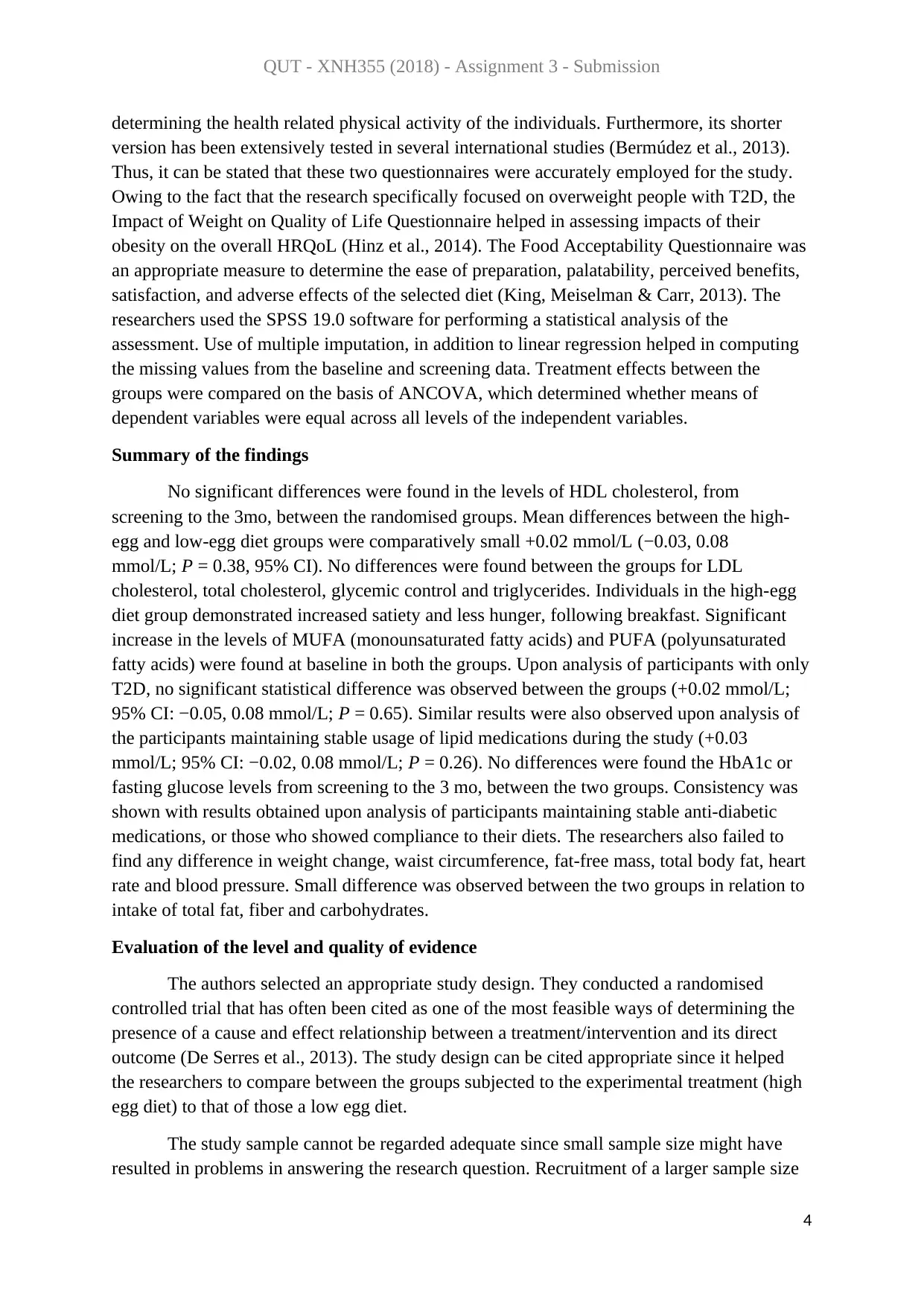
QUT - XNH355 (2018) - Assignment 3 - Submission
determining the health related physical activity of the individuals. Furthermore, its shorter
version has been extensively tested in several international studies (Bermúdez et al., 2013).
Thus, it can be stated that these two questionnaires were accurately employed for the study.
Owing to the fact that the research specifically focused on overweight people with T2D, the
Impact of Weight on Quality of Life Questionnaire helped in assessing impacts of their
obesity on the overall HRQoL (Hinz et al., 2014). The Food Acceptability Questionnaire was
an appropriate measure to determine the ease of preparation, palatability, perceived benefits,
satisfaction, and adverse effects of the selected diet (King, Meiselman & Carr, 2013). The
researchers used the SPSS 19.0 software for performing a statistical analysis of the
assessment. Use of multiple imputation, in addition to linear regression helped in computing
the missing values from the baseline and screening data. Treatment effects between the
groups were compared on the basis of ANCOVA, which determined whether means of
dependent variables were equal across all levels of the independent variables.
Summary of the findings
No significant differences were found in the levels of HDL cholesterol, from
screening to the 3mo, between the randomised groups. Mean differences between the high-
egg and low-egg diet groups were comparatively small +0.02 mmol/L (−0.03, 0.08
mmol/L; P = 0.38, 95% CI). No differences were found between the groups for LDL
cholesterol, total cholesterol, glycemic control and triglycerides. Individuals in the high-egg
diet group demonstrated increased satiety and less hunger, following breakfast. Significant
increase in the levels of MUFA (monounsaturated fatty acids) and PUFA (polyunsaturated
fatty acids) were found at baseline in both the groups. Upon analysis of participants with only
T2D, no significant statistical difference was observed between the groups (+0.02 mmol/L;
95% CI: −0.05, 0.08 mmol/L; P = 0.65). Similar results were also observed upon analysis of
the participants maintaining stable usage of lipid medications during the study (+0.03
mmol/L; 95% CI: −0.02, 0.08 mmol/L; P = 0.26). No differences were found the HbA1c or
fasting glucose levels from screening to the 3 mo, between the two groups. Consistency was
shown with results obtained upon analysis of participants maintaining stable anti-diabetic
medications, or those who showed compliance to their diets. The researchers also failed to
find any difference in weight change, waist circumference, fat-free mass, total body fat, heart
rate and blood pressure. Small difference was observed between the two groups in relation to
intake of total fat, fiber and carbohydrates.
Evaluation of the level and quality of evidence
The authors selected an appropriate study design. They conducted a randomised
controlled trial that has often been cited as one of the most feasible ways of determining the
presence of a cause and effect relationship between a treatment/intervention and its direct
outcome (De Serres et al., 2013). The study design can be cited appropriate since it helped
the researchers to compare between the groups subjected to the experimental treatment (high
egg diet) to that of those a low egg diet.
The study sample cannot be regarded adequate since small sample size might have
resulted in problems in answering the research question. Recruitment of a larger sample size
4
determining the health related physical activity of the individuals. Furthermore, its shorter
version has been extensively tested in several international studies (Bermúdez et al., 2013).
Thus, it can be stated that these two questionnaires were accurately employed for the study.
Owing to the fact that the research specifically focused on overweight people with T2D, the
Impact of Weight on Quality of Life Questionnaire helped in assessing impacts of their
obesity on the overall HRQoL (Hinz et al., 2014). The Food Acceptability Questionnaire was
an appropriate measure to determine the ease of preparation, palatability, perceived benefits,
satisfaction, and adverse effects of the selected diet (King, Meiselman & Carr, 2013). The
researchers used the SPSS 19.0 software for performing a statistical analysis of the
assessment. Use of multiple imputation, in addition to linear regression helped in computing
the missing values from the baseline and screening data. Treatment effects between the
groups were compared on the basis of ANCOVA, which determined whether means of
dependent variables were equal across all levels of the independent variables.
Summary of the findings
No significant differences were found in the levels of HDL cholesterol, from
screening to the 3mo, between the randomised groups. Mean differences between the high-
egg and low-egg diet groups were comparatively small +0.02 mmol/L (−0.03, 0.08
mmol/L; P = 0.38, 95% CI). No differences were found between the groups for LDL
cholesterol, total cholesterol, glycemic control and triglycerides. Individuals in the high-egg
diet group demonstrated increased satiety and less hunger, following breakfast. Significant
increase in the levels of MUFA (monounsaturated fatty acids) and PUFA (polyunsaturated
fatty acids) were found at baseline in both the groups. Upon analysis of participants with only
T2D, no significant statistical difference was observed between the groups (+0.02 mmol/L;
95% CI: −0.05, 0.08 mmol/L; P = 0.65). Similar results were also observed upon analysis of
the participants maintaining stable usage of lipid medications during the study (+0.03
mmol/L; 95% CI: −0.02, 0.08 mmol/L; P = 0.26). No differences were found the HbA1c or
fasting glucose levels from screening to the 3 mo, between the two groups. Consistency was
shown with results obtained upon analysis of participants maintaining stable anti-diabetic
medications, or those who showed compliance to their diets. The researchers also failed to
find any difference in weight change, waist circumference, fat-free mass, total body fat, heart
rate and blood pressure. Small difference was observed between the two groups in relation to
intake of total fat, fiber and carbohydrates.
Evaluation of the level and quality of evidence
The authors selected an appropriate study design. They conducted a randomised
controlled trial that has often been cited as one of the most feasible ways of determining the
presence of a cause and effect relationship between a treatment/intervention and its direct
outcome (De Serres et al., 2013). The study design can be cited appropriate since it helped
the researchers to compare between the groups subjected to the experimental treatment (high
egg diet) to that of those a low egg diet.
The study sample cannot be regarded adequate since small sample size might have
resulted in problems in answering the research question. Recruitment of a larger sample size
4
Paraphrase This Document
Need a fresh take? Get an instant paraphrase of this document with our AI Paraphraser

QUT - XNH355 (2018) - Assignment 3 - Submission
and use of a crossover design where each participant would be subjected to different
treatments during separate time period would have helped in showing significant differences
in primary HDL cholesterol outcomes (Button et al., 2013). Low dropout or withdrawal of
the participants was one major strength that helped the researches to account for most
participants at the end of the trial.
Selection of the participants was done properly since it followed the International
Conference on Harmonization–Good Clinical Practice guidelines, the primary aim of which
is to protect rights of the human subjects who participate in clinical trials, thereby ensuring
credibility and validity of the collected data (Tinto et al., 2013).
However, one major limitation was associated with the fact that the researchers failed
to blind the intervention group, while obtaining the scale ratings for their appetite. Blinding
or concealment are imperative for clinical trials where one or more groups are kept unaware
of the intervention arm to which the participants are subjected to (Hróbjartsson et al., 2013).
Failure to blind them might have resulted in conscious or unconscious bias in the results.
Furthermore, the RCT was also associated with recall bias, which can be attributed to
the presence of a systematic error, caused due to differences in the completeness or accuracy
of the recollections made by the participants, during the use of the questionnaires (Vrijsen et
al., 2014).
However, the overall study suggested that individuals with T2D or prediabetes can be
given a high-egg diet, while reducing their saturated fat intake and maintaining body weight,
with no adverse health effects.
5
and use of a crossover design where each participant would be subjected to different
treatments during separate time period would have helped in showing significant differences
in primary HDL cholesterol outcomes (Button et al., 2013). Low dropout or withdrawal of
the participants was one major strength that helped the researches to account for most
participants at the end of the trial.
Selection of the participants was done properly since it followed the International
Conference on Harmonization–Good Clinical Practice guidelines, the primary aim of which
is to protect rights of the human subjects who participate in clinical trials, thereby ensuring
credibility and validity of the collected data (Tinto et al., 2013).
However, one major limitation was associated with the fact that the researchers failed
to blind the intervention group, while obtaining the scale ratings for their appetite. Blinding
or concealment are imperative for clinical trials where one or more groups are kept unaware
of the intervention arm to which the participants are subjected to (Hróbjartsson et al., 2013).
Failure to blind them might have resulted in conscious or unconscious bias in the results.
Furthermore, the RCT was also associated with recall bias, which can be attributed to
the presence of a systematic error, caused due to differences in the completeness or accuracy
of the recollections made by the participants, during the use of the questionnaires (Vrijsen et
al., 2014).
However, the overall study suggested that individuals with T2D or prediabetes can be
given a high-egg diet, while reducing their saturated fat intake and maintaining body weight,
with no adverse health effects.
5
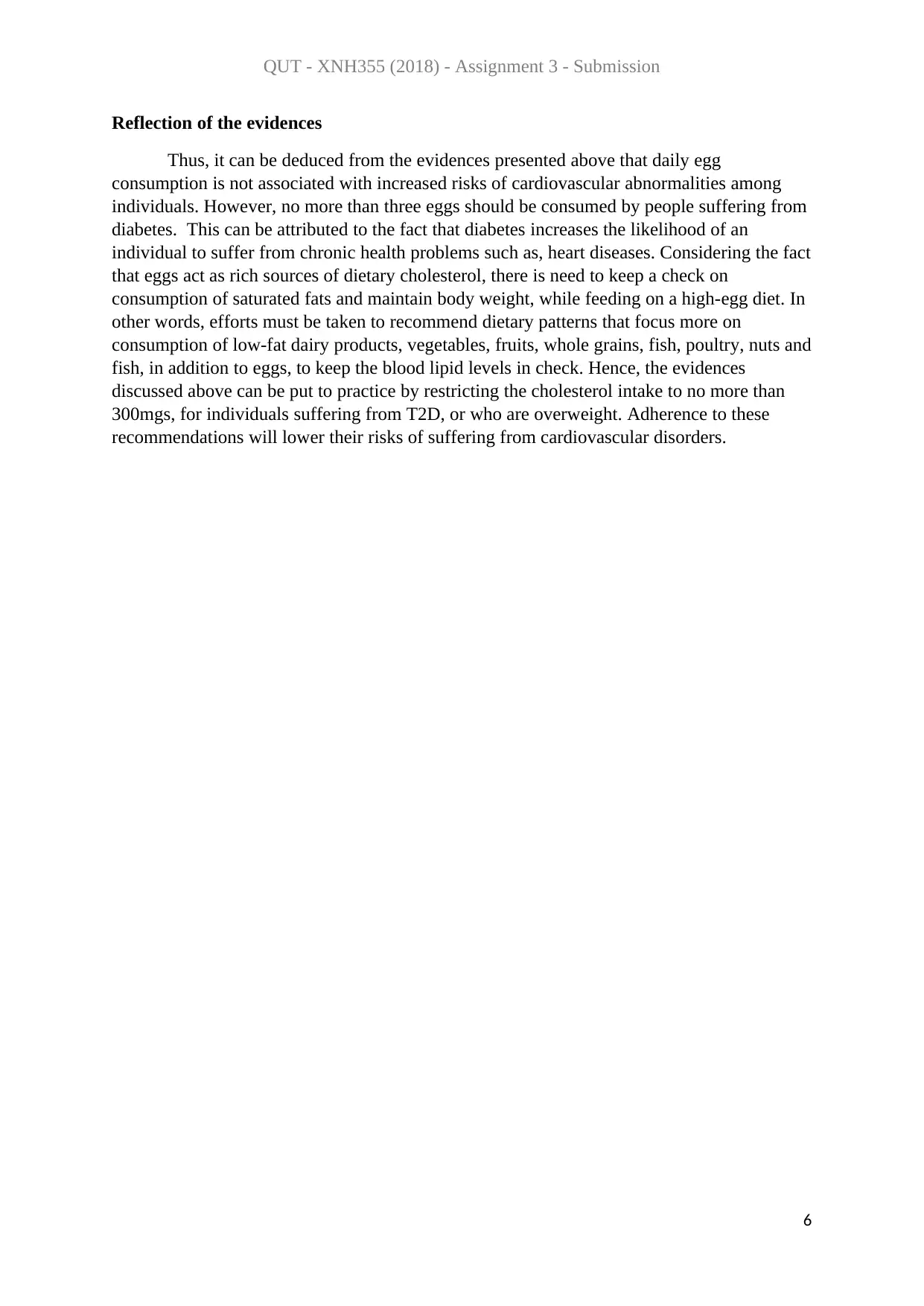
QUT - XNH355 (2018) - Assignment 3 - Submission
Reflection of the evidences
Thus, it can be deduced from the evidences presented above that daily egg
consumption is not associated with increased risks of cardiovascular abnormalities among
individuals. However, no more than three eggs should be consumed by people suffering from
diabetes. This can be attributed to the fact that diabetes increases the likelihood of an
individual to suffer from chronic health problems such as, heart diseases. Considering the fact
that eggs act as rich sources of dietary cholesterol, there is need to keep a check on
consumption of saturated fats and maintain body weight, while feeding on a high-egg diet. In
other words, efforts must be taken to recommend dietary patterns that focus more on
consumption of low-fat dairy products, vegetables, fruits, whole grains, fish, poultry, nuts and
fish, in addition to eggs, to keep the blood lipid levels in check. Hence, the evidences
discussed above can be put to practice by restricting the cholesterol intake to no more than
300mgs, for individuals suffering from T2D, or who are overweight. Adherence to these
recommendations will lower their risks of suffering from cardiovascular disorders.
6
Reflection of the evidences
Thus, it can be deduced from the evidences presented above that daily egg
consumption is not associated with increased risks of cardiovascular abnormalities among
individuals. However, no more than three eggs should be consumed by people suffering from
diabetes. This can be attributed to the fact that diabetes increases the likelihood of an
individual to suffer from chronic health problems such as, heart diseases. Considering the fact
that eggs act as rich sources of dietary cholesterol, there is need to keep a check on
consumption of saturated fats and maintain body weight, while feeding on a high-egg diet. In
other words, efforts must be taken to recommend dietary patterns that focus more on
consumption of low-fat dairy products, vegetables, fruits, whole grains, fish, poultry, nuts and
fish, in addition to eggs, to keep the blood lipid levels in check. Hence, the evidences
discussed above can be put to practice by restricting the cholesterol intake to no more than
300mgs, for individuals suffering from T2D, or who are overweight. Adherence to these
recommendations will lower their risks of suffering from cardiovascular disorders.
6
⊘ This is a preview!⊘
Do you want full access?
Subscribe today to unlock all pages.

Trusted by 1+ million students worldwide
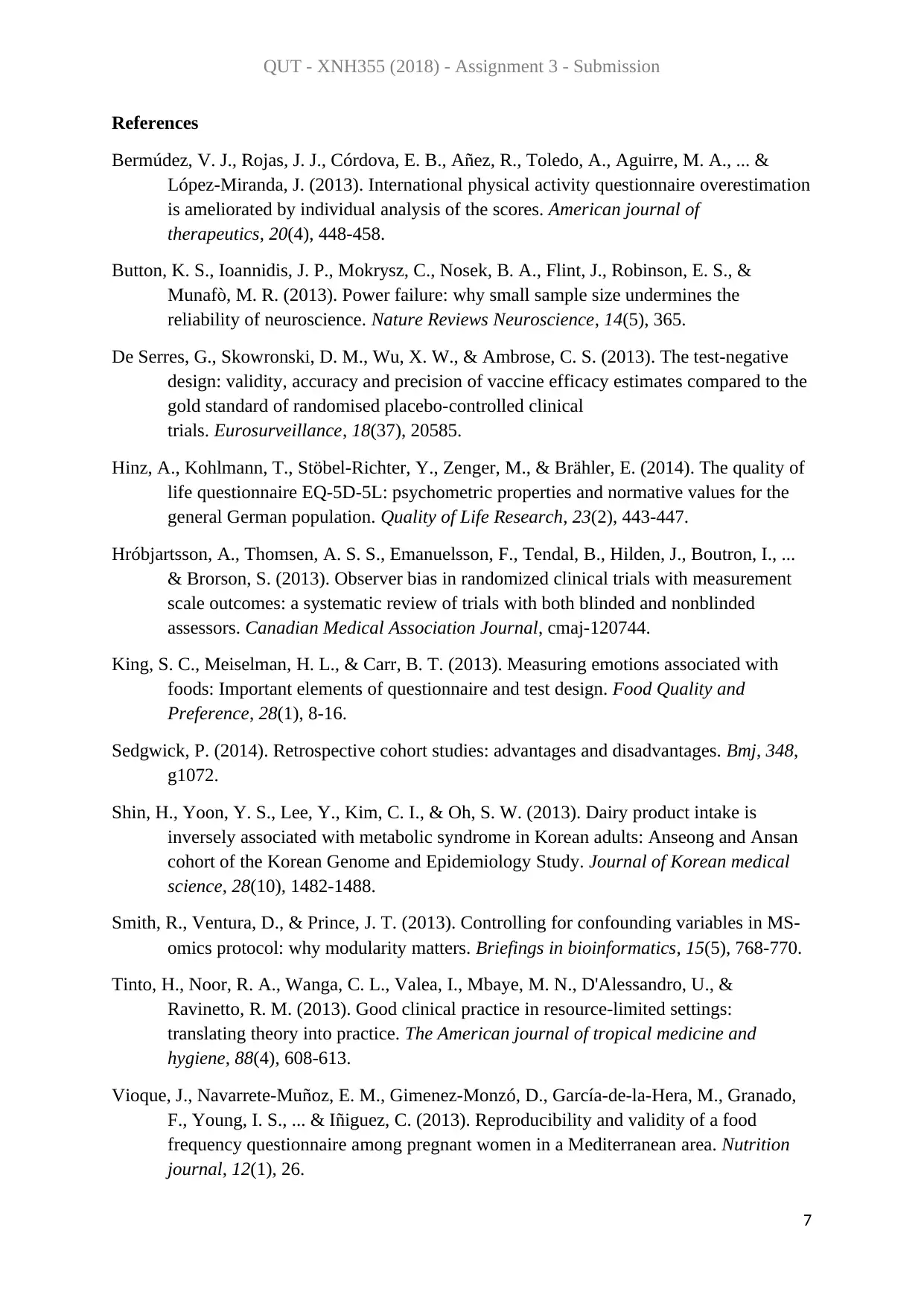
QUT - XNH355 (2018) - Assignment 3 - Submission
References
Bermúdez, V. J., Rojas, J. J., Córdova, E. B., Añez, R., Toledo, A., Aguirre, M. A., ... &
López-Miranda, J. (2013). International physical activity questionnaire overestimation
is ameliorated by individual analysis of the scores. American journal of
therapeutics, 20(4), 448-458.
Button, K. S., Ioannidis, J. P., Mokrysz, C., Nosek, B. A., Flint, J., Robinson, E. S., &
Munafò, M. R. (2013). Power failure: why small sample size undermines the
reliability of neuroscience. Nature Reviews Neuroscience, 14(5), 365.
De Serres, G., Skowronski, D. M., Wu, X. W., & Ambrose, C. S. (2013). The test-negative
design: validity, accuracy and precision of vaccine efficacy estimates compared to the
gold standard of randomised placebo-controlled clinical
trials. Eurosurveillance, 18(37), 20585.
Hinz, A., Kohlmann, T., Stöbel-Richter, Y., Zenger, M., & Brähler, E. (2014). The quality of
life questionnaire EQ-5D-5L: psychometric properties and normative values for the
general German population. Quality of Life Research, 23(2), 443-447.
Hróbjartsson, A., Thomsen, A. S. S., Emanuelsson, F., Tendal, B., Hilden, J., Boutron, I., ...
& Brorson, S. (2013). Observer bias in randomized clinical trials with measurement
scale outcomes: a systematic review of trials with both blinded and nonblinded
assessors. Canadian Medical Association Journal, cmaj-120744.
King, S. C., Meiselman, H. L., & Carr, B. T. (2013). Measuring emotions associated with
foods: Important elements of questionnaire and test design. Food Quality and
Preference, 28(1), 8-16.
Sedgwick, P. (2014). Retrospective cohort studies: advantages and disadvantages. Bmj, 348,
g1072.
Shin, H., Yoon, Y. S., Lee, Y., Kim, C. I., & Oh, S. W. (2013). Dairy product intake is
inversely associated with metabolic syndrome in Korean adults: Anseong and Ansan
cohort of the Korean Genome and Epidemiology Study. Journal of Korean medical
science, 28(10), 1482-1488.
Smith, R., Ventura, D., & Prince, J. T. (2013). Controlling for confounding variables in MS-
omics protocol: why modularity matters. Briefings in bioinformatics, 15(5), 768-770.
Tinto, H., Noor, R. A., Wanga, C. L., Valea, I., Mbaye, M. N., D'Alessandro, U., &
Ravinetto, R. M. (2013). Good clinical practice in resource-limited settings:
translating theory into practice. The American journal of tropical medicine and
hygiene, 88(4), 608-613.
Vioque, J., Navarrete-Muñoz, E. M., Gimenez-Monzó, D., García-de-la-Hera, M., Granado,
F., Young, I. S., ... & Iñiguez, C. (2013). Reproducibility and validity of a food
frequency questionnaire among pregnant women in a Mediterranean area. Nutrition
journal, 12(1), 26.
7
References
Bermúdez, V. J., Rojas, J. J., Córdova, E. B., Añez, R., Toledo, A., Aguirre, M. A., ... &
López-Miranda, J. (2013). International physical activity questionnaire overestimation
is ameliorated by individual analysis of the scores. American journal of
therapeutics, 20(4), 448-458.
Button, K. S., Ioannidis, J. P., Mokrysz, C., Nosek, B. A., Flint, J., Robinson, E. S., &
Munafò, M. R. (2013). Power failure: why small sample size undermines the
reliability of neuroscience. Nature Reviews Neuroscience, 14(5), 365.
De Serres, G., Skowronski, D. M., Wu, X. W., & Ambrose, C. S. (2013). The test-negative
design: validity, accuracy and precision of vaccine efficacy estimates compared to the
gold standard of randomised placebo-controlled clinical
trials. Eurosurveillance, 18(37), 20585.
Hinz, A., Kohlmann, T., Stöbel-Richter, Y., Zenger, M., & Brähler, E. (2014). The quality of
life questionnaire EQ-5D-5L: psychometric properties and normative values for the
general German population. Quality of Life Research, 23(2), 443-447.
Hróbjartsson, A., Thomsen, A. S. S., Emanuelsson, F., Tendal, B., Hilden, J., Boutron, I., ...
& Brorson, S. (2013). Observer bias in randomized clinical trials with measurement
scale outcomes: a systematic review of trials with both blinded and nonblinded
assessors. Canadian Medical Association Journal, cmaj-120744.
King, S. C., Meiselman, H. L., & Carr, B. T. (2013). Measuring emotions associated with
foods: Important elements of questionnaire and test design. Food Quality and
Preference, 28(1), 8-16.
Sedgwick, P. (2014). Retrospective cohort studies: advantages and disadvantages. Bmj, 348,
g1072.
Shin, H., Yoon, Y. S., Lee, Y., Kim, C. I., & Oh, S. W. (2013). Dairy product intake is
inversely associated with metabolic syndrome in Korean adults: Anseong and Ansan
cohort of the Korean Genome and Epidemiology Study. Journal of Korean medical
science, 28(10), 1482-1488.
Smith, R., Ventura, D., & Prince, J. T. (2013). Controlling for confounding variables in MS-
omics protocol: why modularity matters. Briefings in bioinformatics, 15(5), 768-770.
Tinto, H., Noor, R. A., Wanga, C. L., Valea, I., Mbaye, M. N., D'Alessandro, U., &
Ravinetto, R. M. (2013). Good clinical practice in resource-limited settings:
translating theory into practice. The American journal of tropical medicine and
hygiene, 88(4), 608-613.
Vioque, J., Navarrete-Muñoz, E. M., Gimenez-Monzó, D., García-de-la-Hera, M., Granado,
F., Young, I. S., ... & Iñiguez, C. (2013). Reproducibility and validity of a food
frequency questionnaire among pregnant women in a Mediterranean area. Nutrition
journal, 12(1), 26.
7
Paraphrase This Document
Need a fresh take? Get an instant paraphrase of this document with our AI Paraphraser

QUT - XNH355 (2018) - Assignment 3 - Submission
Vrijsen, J. N., Becker, E. S., Rinck, M., van Oostrom, I., Speckens, A., Whitmer, A., &
Gotlib, I. H. (2014). Can memory bias be modified? The effects of an explicit cued-
recall training in two independent samples. Cognitive therapy and research, 38(2),
217-225.
Woodward, M. (2013). Epidemiology: study design and data analysis. CRC press.
8
Vrijsen, J. N., Becker, E. S., Rinck, M., van Oostrom, I., Speckens, A., Whitmer, A., &
Gotlib, I. H. (2014). Can memory bias be modified? The effects of an explicit cued-
recall training in two independent samples. Cognitive therapy and research, 38(2),
217-225.
Woodward, M. (2013). Epidemiology: study design and data analysis. CRC press.
8
1 out of 8
Related Documents
Your All-in-One AI-Powered Toolkit for Academic Success.
+13062052269
info@desklib.com
Available 24*7 on WhatsApp / Email
![[object Object]](/_next/static/media/star-bottom.7253800d.svg)
Unlock your academic potential
Copyright © 2020–2025 A2Z Services. All Rights Reserved. Developed and managed by ZUCOL.



